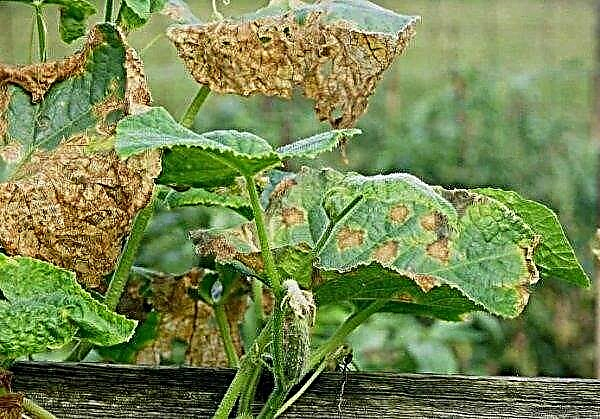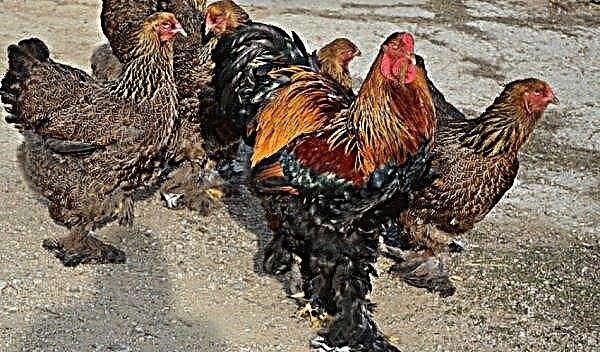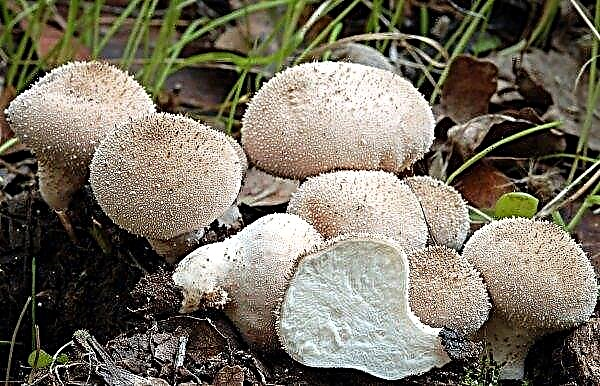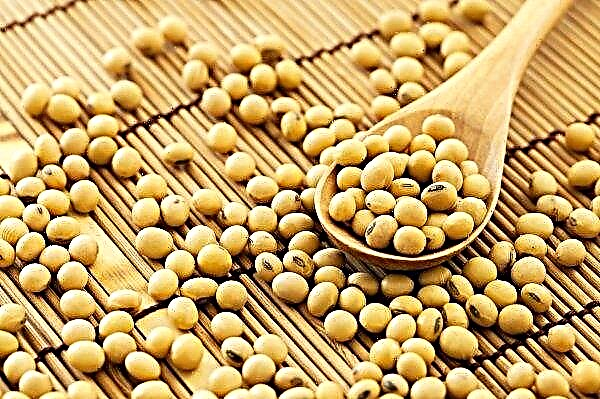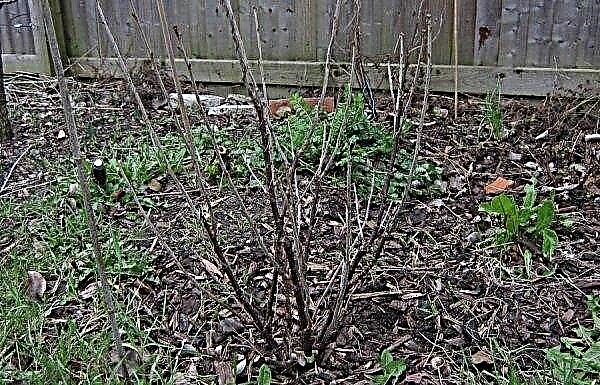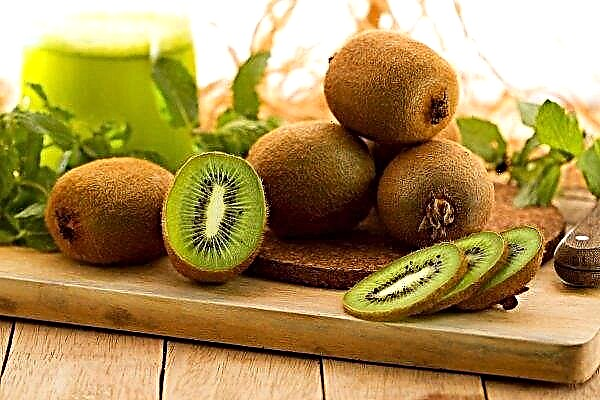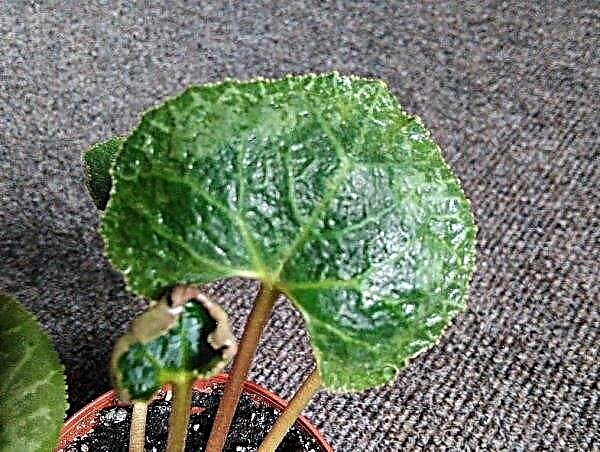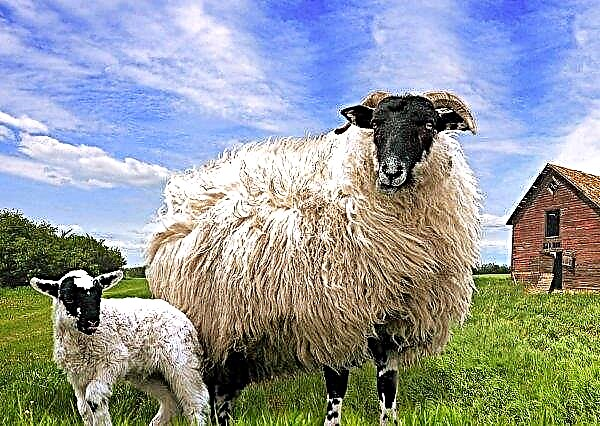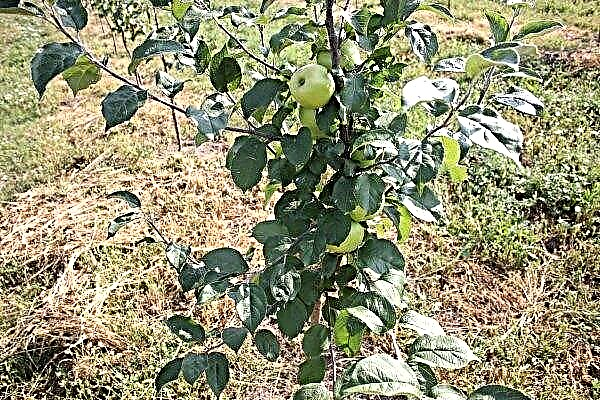Chinese cabbage is a frequent guest at the tables of domestic consumers, however, not many vegetable growers are engaged in its cultivation today. And it’s completely in vain, because the “Asian” is quite unpretentious in leaving, has good resistance to frost and is well established in the new climate. How to cultivate a vegetable, and when it is necessary to harvest - further in the article.
Description and characteristic
Chinese cabbage is a two-year-old herbaceous culture of the Cruciferous family, which is grown as an annual. In modern Russia, the vegetable appeared at the end of the XIX century. Over the years, cabbage has gone through numerous selection paths, as a result of which several varieties have been created, many of which are especially successful because they can take root even in cold climates.
During ripening, cabbage forms a rosette of leaves or heads of cabbage, which differ in various shapes and densities. The leaves of the vegetable are very tender, almost airy, with a wrinkled leaf surface, 15–35 cm long, with wavy or jagged edges and a pronounced central vein. The color of the leaves, depending on the variety of culture, can vary from light yellow to saturated green.
Today, two types of Asian plants are most popular among vegetable growers:
- Beijing cabbage, or salad (Chinese salad). It is distinguished by the presence of white stems with wide light green leaves collected in a loose, elongated head of cabbage.

- Chinese cabbage pak choi. It is presented in the form of a rosette of erect leaves, with a diameter of 30–35 cm and a length of 10–50 cm. The leaves of the culture are very delicate, green in color, with white petioles closely adjacent to each other.

The variety of Chinese cabbage determines its maturity.
Important! Quite often, both varieties of cabbage are combined into one under the general name "Chinese cabbage", however, from the point of view of botany, this is not true, because, despite the similarities, growing plants has its own characteristics and individual rules.
Exist:
- early crops with a vegetation period of 40–55 days;
- mediumin which harvesting is carried out after 55-60 days;
- late, with a maturity of 60–80 days.

Advantages and disadvantages of Chinese cabbage
- Chinese cabbage has a wide range of advantages, thanks to which it fell in love with domestic vegetable growers:
- fast ripening;
- the ability to grow a crop year-round, in open ground or a greenhouse;
- stable, decent harvest;
- resistance to frost;
- strong immunity and resistance to many diseases;
- good keeping quality.
- Not without a vegetable and disadvantages, among which one can note:
- shootings of the crop in case of non-compliance with the optimal growing conditions;
- the tendency of some varieties of cabbage to bloom, after which it loses its taste.
Features of growing seedlings
In the domestic climate, Asian cabbage of different ripening periods is cultivated. The rules for their cultivation and care are almost identical, however, different varieties should be planted at a certain distance so that they do not come into "conflict" with each other.
Did you know? Cabbage is an indispensable source of vitamin K. 100 g of vegetable contains 63% of the daily human need for this substance. Note that vitamin K activates brain activity and is a prophylactic against Alzheimer's disease.
Chinese cabbage can be planted by the seedling method or by pre-growing seedlings. Domestic vegetable growers practice the latter method, since it is more effective.
Seeding time
Sowing seeds for seedlings is necessary 30–35 days before the proposed planting of seedlings in open soil. If it is necessary to obtain a summer crop, it is advisable to sow seeds in the last weeks of March or in early April. If you plan to get fruits for the winter, then it is recommended to sow the seeds in the last days of June or the first week of July.
Seed preparation
Immediately before seeding the seed material into the substrate, it must be properly prepared.
For this:
- the seeds are wrapped in a piece of cloth or gauze, dipped in a container with warm water at a temperature of about + 45 ... + 50 ° C, for 15-25 minutes;
- after the specified time, the material is cooled for 1-2 minutes in cold water;
- the seeds are transferred to a special stimulant solution enriched with minerals and left for 12 hours.
 If sowing of seed material is planned to be carried out on the next day, it is recommended to leave it in a refrigerator at a temperature of -10 ° С. Such preparation allows you to accelerate the process of seed germination, increase the protective function of the seed material and its resistance to negative external factors.
If sowing of seed material is planned to be carried out on the next day, it is recommended to leave it in a refrigerator at a temperature of -10 ° С. Such preparation allows you to accelerate the process of seed germination, increase the protective function of the seed material and its resistance to negative external factors.Preparation of soil for seedlings
Despite the fact that cabbage does not impose special requirements on the soil, for quick and successful growing seedlings, experts advise to prepare a special loose and nutritious soil mixture consisting of coconut soil and humus.
Chinese cabbage is quite negative about diving, so it is recommended to sow seeds for seedlings immediately in special peat pots, which will subsequently be planted in open ground.
Crop conditions and care
Sowing seed material for seedlings is carried out according to the following algorithm:
- The soil is abundantly moistened.
- A 1.2–2 cm deepening is made in the substrate and 2–3 grains are laid.
- Glasses with seeds are stored in a common container, for example, in a container, and placed in a dark room until the first shoots appear.
- After the shoots have risen, the containers with seedlings are transferred to a well-lit place, with temperature indicators + 15 ... + 18 ° С.
- Crops, as the topsoil dries up, are regularly moistened with a spray bottle.
- When 2-3 full leaves appear on the sprouts, one strong and strong sprout is left in the cups, and the weak ones are pinched off.

Seedling hardening
About 2 weeks before the alleged planting of seedlings in open soil, measures for its hardening begin. To do this, the container with sprouts is transferred to the balcony or loggia for several hours, daily increasing the time spent by the seedlings in the open air.
The day before the seedling material is planted in the ground, it is left on the street for a day. Such procedures will strengthen the immune system of the plant, increase its resistance to ailments and parasites, accelerate adaptation to new environmental conditions.
Important! A week before planting in the ground, seedlings are no longer watered.
Planting seedlings in open ground
Vegetable prefers to grow in open, bright areas, reliably protected from drafts and cold winds. A good place for cabbage will be the western or eastern side of the site, which is dominated by loose, light and nutritious soil with a neutral level of acidity. An ideal option for planting a crop is loamy soil, which is characterized by moderate humidity and drainage. When growing cabbage on acidic soil, it should be lime in the fall, and in the spring enriched with a mixture of humus and compost. The plant bears fruit well and develops in areas where legumes, cereals, onions, cucumbers, and garlic used to grow. It is not advisable to grow vegetables after tomatoes and beets, as they tend to be affected by identical diseases.
When growing cabbage on acidic soil, it should be lime in the fall, and in the spring enriched with a mixture of humus and compost. The plant bears fruit well and develops in areas where legumes, cereals, onions, cucumbers, and garlic used to grow. It is not advisable to grow vegetables after tomatoes and beets, as they tend to be affected by identical diseases.
Did you know? Residents of the East believe that daily use of cabbage can extend life for several years.
The landing technology is based on the following steps:
- Before planting, the soil is slightly loosened.
- Dig holes in which peat tablets with seedlings are placed at intervals of 30 cm. When growing seedlings in plastic cups, the sprouts are carefully taken out of the containers by the method of transshipment and, together with a lump of earth, they are lowered into the ground.
- By sticking cabbage into the holes, the root processes are gently covered with soil, the surface is slightly tamped.
- Planting is abundantly moistened with cold, standing water.

Plant care
When caring for Chinese cabbage, it is recommended to adhere to some simple but important rules that will allow you to achieve a high and high-quality crop.
Fertilizer and Watering
Abundant and timely watering is one of the main points of successful growth of a vegetable. Cabbage responds positively to profuse hydration, which should be performed every 7 days. The plant is watered under the root, using settled, warm water, do it in cloudy, morning or evening time. When carrying out irrigation measures, you need to ensure that moisture does not fall on the foliage, otherwise yellow, dry spots will form on it.
For the full development of the “Asian”, she needs to organize top dressing, the first of which is recommended to be carried out 2 weeks after transplanting seedlings into the ground. For the nutrition of the vegetable, nitrogen-containing preparations are used, at the rate of 10 g of the product per 1 m² of soil. It is very important not to overdo it with nitrogen fertilizers, since their increased content in the soil can provoke plant diseases.Important! Do not allow stagnation of moisture in the soil, as this can provoke rotting of the root system.
 Over the entire growing season, the culture must be nourished 3-4 times, while 2 feeding can be done using a mullein solution. Foliar top dressing with the use of boric acid has a positive effect on the formation of the head, so they should also be carried out several times during the season.
Over the entire growing season, the culture must be nourished 3-4 times, while 2 feeding can be done using a mullein solution. Foliar top dressing with the use of boric acid has a positive effect on the formation of the head, so they should also be carried out several times during the season.Soil loosening
Since cabbage prefers to grow on light, breathable soils, it is necessary to regularly carry out the cultivation procedure, which will allow:
- enrich the soil with oxygen and nutrients required for plant growth;
- activate the growth of the root system.
 Loosening is advised to be carried out shallow. After 2 weeks after transplanting the seedlings, you can mulch the soil around the bushes with a layer of straw, hay or sawdust. Mulching will make it possible to prevent the evaporation of moisture from the soil and will prevent the growth of weeds.
Loosening is advised to be carried out shallow. After 2 weeks after transplanting the seedlings, you can mulch the soil around the bushes with a layer of straw, hay or sawdust. Mulching will make it possible to prevent the evaporation of moisture from the soil and will prevent the growth of weeds.Pest and Disease Control
Chinese cabbage has a fairly strong immunity to many diseases, but in some cases it can become a “victim” of pests, which include:
- Cruciferous flea. The parasite feeds on cabbage leaves, as a result of which small holes, holes, are formed on the leaf plate, which are subsequently transformed into solid holes. To control the flea, the culture is treated with infusion of garlic, wood ash or tobacco dust.

- Aphid. The main food for the insect, which "settles" on the underside of the leaf, is cabbage juice. A dehydrated plant quickly loses strength, energy, as a result of which it fades, deforms and lags behind in development. To destroy the parasite, spraying the leaves with tobacco or onion infusion is great.

- Slug. Pests are dangerous in that they eat almost all parts of the vegetable, as a result of which it can die. To avoid crop loss, the soil around the bushes should be covered with a mixture of wood ash, red pepper, salt and mustard powder.

When growing Chinese cabbage, many vegetable growers may encounter a number of difficulties associated with violations of the basic rules of agricultural technology:
- Black dots on a leaf plate. The cause of their appearance may be a fungal ailment caused by conidia or metabolic disorders.

- Shooting and inflorescence. Cabbage begins to bloom and form arrows due to any stress: irregular watering, overheating, lack of lighting in spring, etc. In order to avoid such problems, it is recommended not to expose the crop to stressful situations, and also select hybrid varieties of cabbage that are not susceptible to planting rifle shooting and flowering.
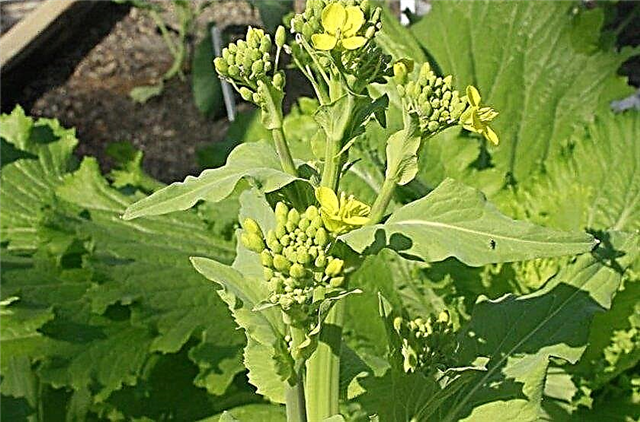
- Do not tie stitches. In order for the vegetable to form a firm head, you can regularly spray it with a solution of boric acid, at the rate of 2 g per 10 liters of water.
Simple, but very effective preventive measures will help prevent the development of various ailments and the appearance of parasites:
- timely weed removal;
- regular weeding of the soil;
- soil moisture control;
- preventive spraying of plants with insecticidal and fungicidal preparations.
Did you know? The birthplace of Chinese cabbage is the People's Republic of China, where the vegetable began to be cultivated more than 5 thousand years ago. But in Japan, culture is used not only as a delicious vegetable, but also as an ornamental plant in landscape design.
Harvesting and storage
The time when you should harvest Chinese cabbage will depend on the period of planting of seedlings. Typically, a crop of cabbage planted in April is harvested in August. However, it is not used for long-term storage and is suitable exclusively for immediate use. For harvesting vegetables for the winter, seedlings are planted in June, and the fruits are harvested in October. Harvesting is recommended in dry, warm weather. During the event, the heads of cabbage are carefully cut with a sharpened, disinfected knife, stepping back from the base 1.5–2 cm. For safety, the heads are taken out for the winter, without any mechanical damage and rotted, which are wrapped in cling film and carefully stored in wooden or plastic boxes .
During the event, the heads of cabbage are carefully cut with a sharpened, disinfected knife, stepping back from the base 1.5–2 cm. For safety, the heads are taken out for the winter, without any mechanical damage and rotted, which are wrapped in cling film and carefully stored in wooden or plastic boxes .
The optimal conditions for storing vegetables are:
- dry, cool, well-ventilated room;
- temperature indicators at the level of + 1 ... + 3 ° С;
- humidity is 80–90%.
Providing the necessary conditions, cabbage can be stored without losing its aesthetic and taste for 3-4 months. Chinese cabbage is an extremely tasty and healthy vegetable, which is able to become a full-fledged source of mineral components and biologically active substances necessary to maintain normal human life. Cultivating a vegetable does not require much effort, and subject to the basic rules of agricultural technology, you can get a decent harvest of wholesome fruits.
Cultivating a vegetable does not require much effort, and subject to the basic rules of agricultural technology, you can get a decent harvest of wholesome fruits.








